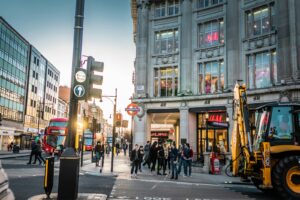According to The Local Data Company, one in six shops across the UK is vacant. The report suggests that while some places, such as Cambridge, occupancy rate is has high as 94%, across 700 other locations there are clusters where vacancy rates are much higher. In Stockport the rate is as high as 30%. Elsewhere in places such as Nottingham, Grimsby, Wolverhampton and Blackburn the rate is one empty shop in four.
Whatever the cause, the high street retail model is failing in many places although we should be careful how we attribute the changes occupation levels. Close to where I live in Liverpool, the Edge Lane retail park has a 50% vacancy rate which suggests there may be problems for retail parks too.
Unpublished research by myself and Jeremy Nicholls suggests that supermarkets have had a mixed effect on local retail – it wasn’t all negative. Online shopping continues apace but remains a small proportion of total retail expenditure and of course the decline of the high street has been ongoing longer than the internet has been in existence. Ultimately, there is more retail space than there is demand for retail activity. Stimulating new demand or changing the existing demand model is not an easy task.
While we do need to understand the causes, it’s also important that we focus on finding solutions. The Portas review recently led the way in trying to re-imagine the high street. Neil McInroy wrote a useful blog that covered some of the weaknesses, especially on the failure to address the issue of demand and that the review doesn’t offer a way to move beyond a shopping list of high street wishes.
Nevertheless, it was a useful starting point and raised the agenda sufficiently for DCLG to launch a £1m fund to help find novel solutions in 12 pilot areas. Significantly, the Portas review positioned the high street at the heart of community.
High streets remain massively important to the notion of place. They are a hub for social interaction, explicitly creating a constant dynamic of place: a confluence of the known and the unknown, of friends and strangers, of the planned and unplanned. The high street is an opportunity for us to check our identity and redefine both the personal self and civic self.
These opportunities reinforce and reinvigorate social networks, keeping the connections and dependencies above the critical level to nourish the idea of belonging. Ultimately, this affects our sense of place and our sense of self and the continual decay undermines community and individual resilience.
Nicola Wass recently blogged how changes to the high street in north Liverpool had left fewer places for the community to congregate. She described how fewer places had steadily deprived the community of casual meeting places, meaning that young residents were more likely to do their socialising in another part of the city while older residents were more likely to remain in their own homes. She noted how one resident encapsulated the problem: ‘In order for there to be resilience, there must be some place to resiliate.’
Last week Dan Thompson from the Empty Shop Network launched his ‘Pop Up People’ report which documents the growing movement of re-use of vacant shops on high streets across UK. The report, funded by the Arts Council, has a particular bent towards the arts and the re-positioning of shops as temporary galleries, studios and workshops. The growing Pop-Up movement shows that we can do something novel on the high streets.
There are many potential uses for former shops including office space, residential, community facilities and so on. It doesn’t have to be solely about retail space. We need to get all stakeholders including landlords and local authorities thinking about this and creating new opportunities for re-imagining the high street.
We need lots of new activity to give traction to this essential cultural and economic shift. The Portas Pilot Fund is an important piece of the jigsaw. PopUpPeople is a useful model of inspiration. And Julian Dobson is pulling an event together in the spring to bring people together to share ideas and successes. And last weekend I attended an event in Preston where a group of people began to explore how hyper-local social media can help to build build and sustain the networks that will begin the long process of making the high street relevant again.
To maintain the importance of the high street at the heart of the community, we need to think creatively about the long-term repositioning and reinvention of the spaces to keep people coming to and through the high street. We don’t need to shop on the high street but it’s essential we can interact there. The high street is critical to community resilience and wellbeing, it’s worth doing something about it.

















Leave a Reply